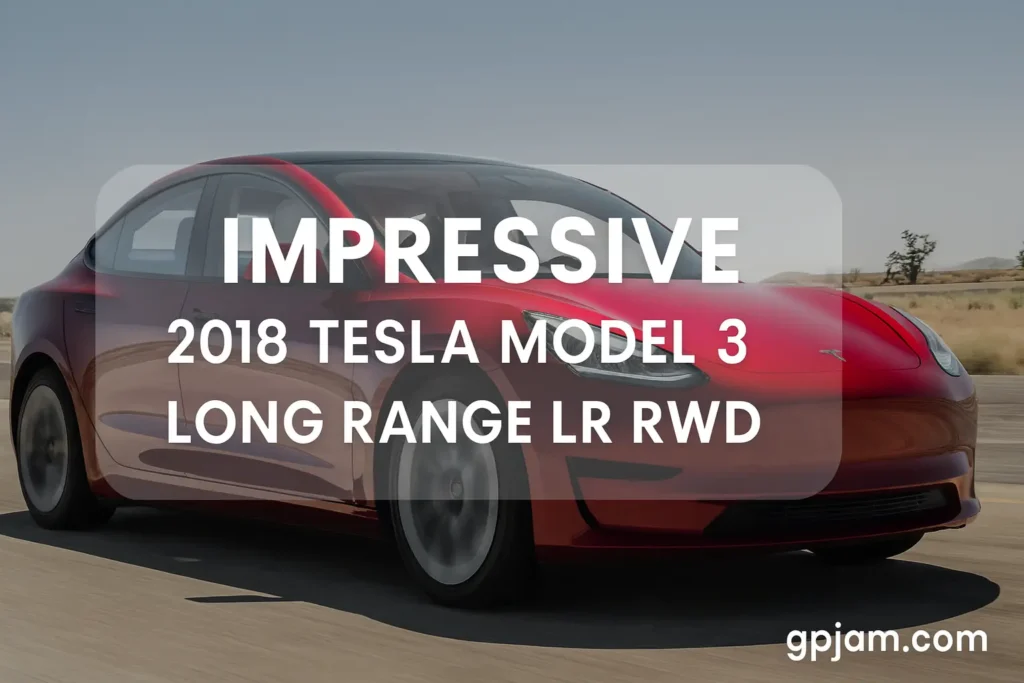If you’re curious about the 2018 Tesla Model 3 LR RWD, you’ve landed at the right place. The Tesla Model 3 has made waves since its debut, and the 2018 model year was a pivotal point in the electric vehicle (EV) revolution. Let’s dive into everything you need to know about this electric car, covering mileage, performance, battery packs, and how it compares to newer models like the 2021 Tesla Model 3 or the 2022 versions.
What Makes the 2018 Tesla Model 3 LR RWD Special?
Tesla launched the Model 3 LR RWD as a game-changer for affordable yet high-performance EVs. Unlike the Standard Range version with 220 miles, the LR RWD variant boasted an impressive 310 miles on a single charge. Back in 2018, this figure outperformed most competitors, setting a benchmark for range in all-electric sedans.

The 2018 Model 3 LR RWD is powered by a strong electric motor with a permanent magnet design, delivering instant torque and smooth acceleration. Tesla Motors paired it with a larger battery pack and advanced battery cells that gave owners confidence for longer trips.
How Does Mileage Hold Up on a High Mileage Tesla Model 3?
One big question EV shoppers ask: What happens when the mileage gets high? With many 2018 Tesla Model 3 LR RWD units now surpassing 100,000 miles, owners are pleasantly surprised. Battery degradation is relatively low, often around 10% after years of use. That means even a high mileage 2018 LR RWD can still push over 270 miles per charge.
The high mileage performance of this car is proof that Tesla’s battery pack and battery cells are designed to last. The use of cathode materials and efficient heat pump systems in newer models has improved durability even further, but the 2018 variant still holds strong in reliability.
Driving Range and Battery Pack Details
The 2018 Tesla Model 3 LR RWD used an estimated 75 kWh battery pack. Real-world driving range varied depending on conditions but was consistently close to the promised 310 miles. Unlike the Tesla Model 3 Standard Range Plus or 3 Standard Range Plus RWD, which focused on affordability, the LR RWD prioritized distance.
Charging is another highlight. Owners report solid charging rates, especially at Tesla Superchargers. With V2 Superchargers, you can regain about 170 miles in 30 minutes. Later models like the 2021 Tesla Model 3 with long range AWD benefit from faster rates, but the 2018 still holds up well.
How Does It Compare With AWD Versions?
Many buyers wonder if they should go for long range AWD instead of the 2018 LR RWD. AWD models offer quicker acceleration and better traction in snow or rain. However, the LR RWD variant tends to be slightly more efficient, delivering a few extra miles of range thanks to reduced drivetrain losses.
If you live in areas with mild weather, the 2018 Tesla Model 3 LR RWD may actually be the smarter pick, balancing range with affordability.
Standard Range vs LR RWD: Which Is Better?
The Tesla Model 3 Standard Range and Standard Range Plus versions were introduced later to offer a more budget-friendly entry into EVs. They came with ranges closer to 220–250 miles. While adequate for city driving, these couldn’t compete with the 310 miles of the LR RWD model.
For buyers comparing standard range version with the long range AWD or LR RWD, the choice usually comes down to driving habits. If you frequently travel or road trip, the LR RWD is the clear winner.
Real Ownership Experience and Reviews
Tesla Model 3 reviews from Car and Driver, Kelley Blue Book, and everyday owners highlight the sedan’s strong value proposition. Early adopters of the 2018 Tesla Model 3 LR RWD often emphasize smooth driving dynamics, minimalist interiors, and strong performance compared to gas sedans.
Yes, some owners reported quality-control hiccups in 2018, but most agree the ownership experience outweighs minor issues. Many call it the best new Tesla purchase they’ve ever made.
Comparing to Later Models: 2021 and 2022 Tesla Model 3
Fast forward to the 2021 Tesla Model 3 and 2022 Tesla Model 3, Tesla introduced improvements like LFP batteries, new cells, and improved aerodynamics. The addition of a heat pump boosted cold-weather efficiency, while design tweaks refreshed the interior and exterior.
Still, the 2018 model year remains attractive for buyers who want solid range at a used price. Even today, it stacks well against many new EVs.
Tesla Model 3 vs Tesla Model X
You might wonder how the Tesla Model 3 LR RWD stacks up against a bigger Tesla Model X. While the Model X offers more space and AWD by default, the Model 3 shines in efficiency and price. A sedan with the ability to travel miles on a single charge, it’s far more practical for daily commuting.
Technical Insights: kWh, Battery Cells, and Motor Design
The 2018 Tesla Model 3 LR RWD had around 75–80 kWh of usable capacity. With about 4,000+ battery cells structured in a module design, the pack delivered high durability. The use of magnet motor technology provided excellent efficiency at highway speeds.
Future-facing innovations like new Tesla Model 3 packs may introduce higher kWh numbers, but the 2018 variant still proves how well-engineered Tesla’s early designs were.
Why Mileage Still Matters in EVs
Unlike gas cars, mileage in EVs doesn’t just mean wear and tear—it’s also about how the battery holds up. The 2018 Tesla Model 3 LR RWD shows that with good design, an EV can maintain strong performance even with high mileage. For many buyers, this makes a used Tesla an appealing investment.
Conclusion
The 2018 Tesla Model 3 LR RWD remains one of the most compelling EVs on the used market. With a strong driving range, durable battery pack, and proven electric motor technology, it continues to deliver value years after release. Whether you’re comparing it to the Tesla Model 3 Standard Range Plus, the 2021 Tesla Model 3, or even a new Tesla, the 2018 model year holds its ground as a reliable, efficient, and enjoyable sedan. If you’re in the market for a practical yet performance-driven EV, the 2018 LR RWD deserves serious consideration.
FAQ
How many miles can a 2018 Tesla Model 3 LR RWD go on a charge?
It was rated for 310 miles on a single charge, with real-world numbers often close to that depending on conditions.
Is high mileage a concern for the 2018 Tesla Model 3 LR RWD?
Not really. Even at over 100,000 miles, many owners report only about 10% degradation, keeping range above 270 miles.
How does the 2018 Model 3 LR RWD compare to the AWD version?
AWD adds traction and acceleration, but LR RWD is slightly more efficient with a longer range.
What’s the difference between Standard Range and LR RWD versions?
Standard Range offered about 220–250 miles, while the LR RWD provided 310 miles, making it better for road trips.
Should I buy a 2018 Tesla Model 3 LR RWD in 2025?
Yes, if you’re looking for a balance of affordability, range, and proven battery life, it’s still a strong option among used EVs.






